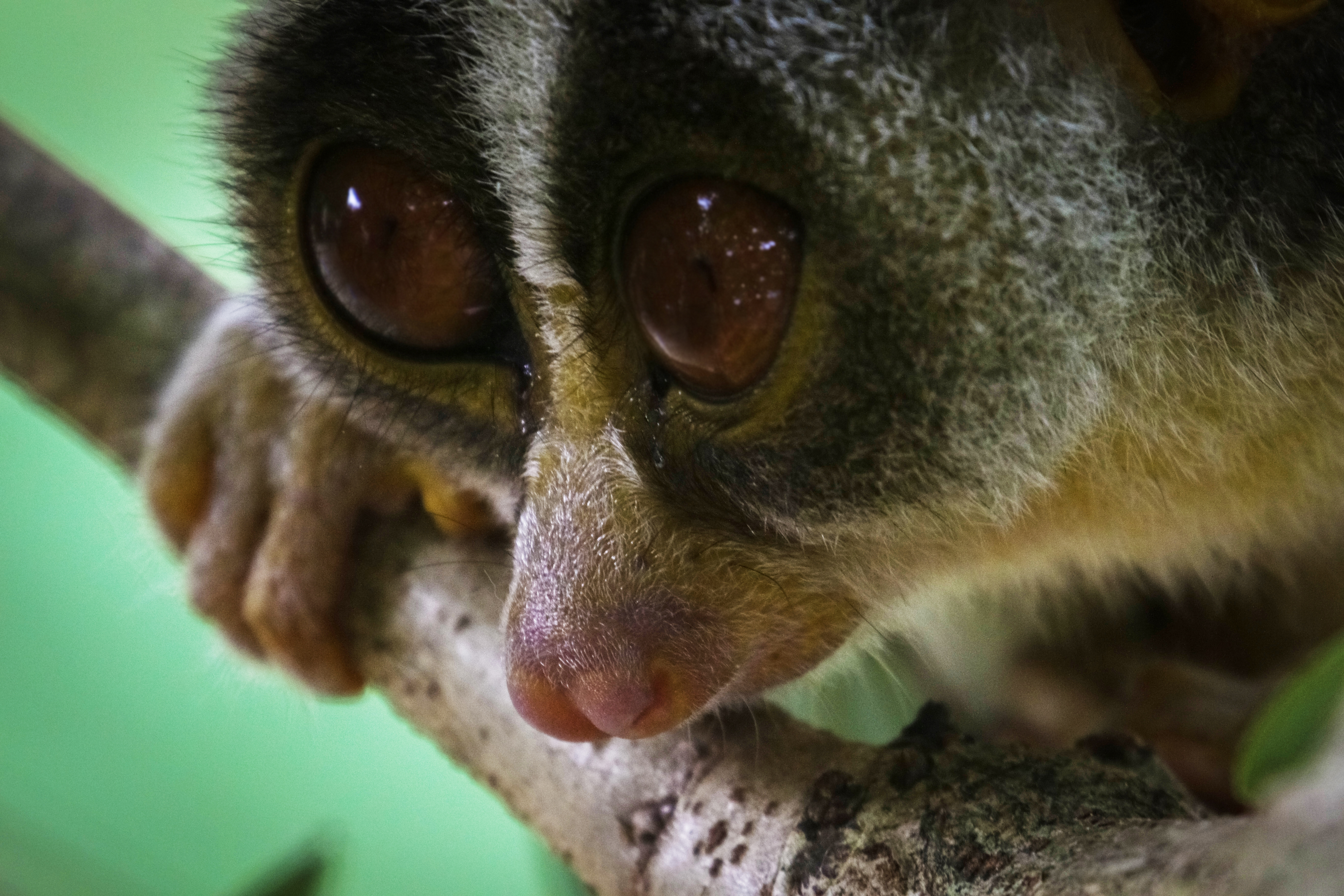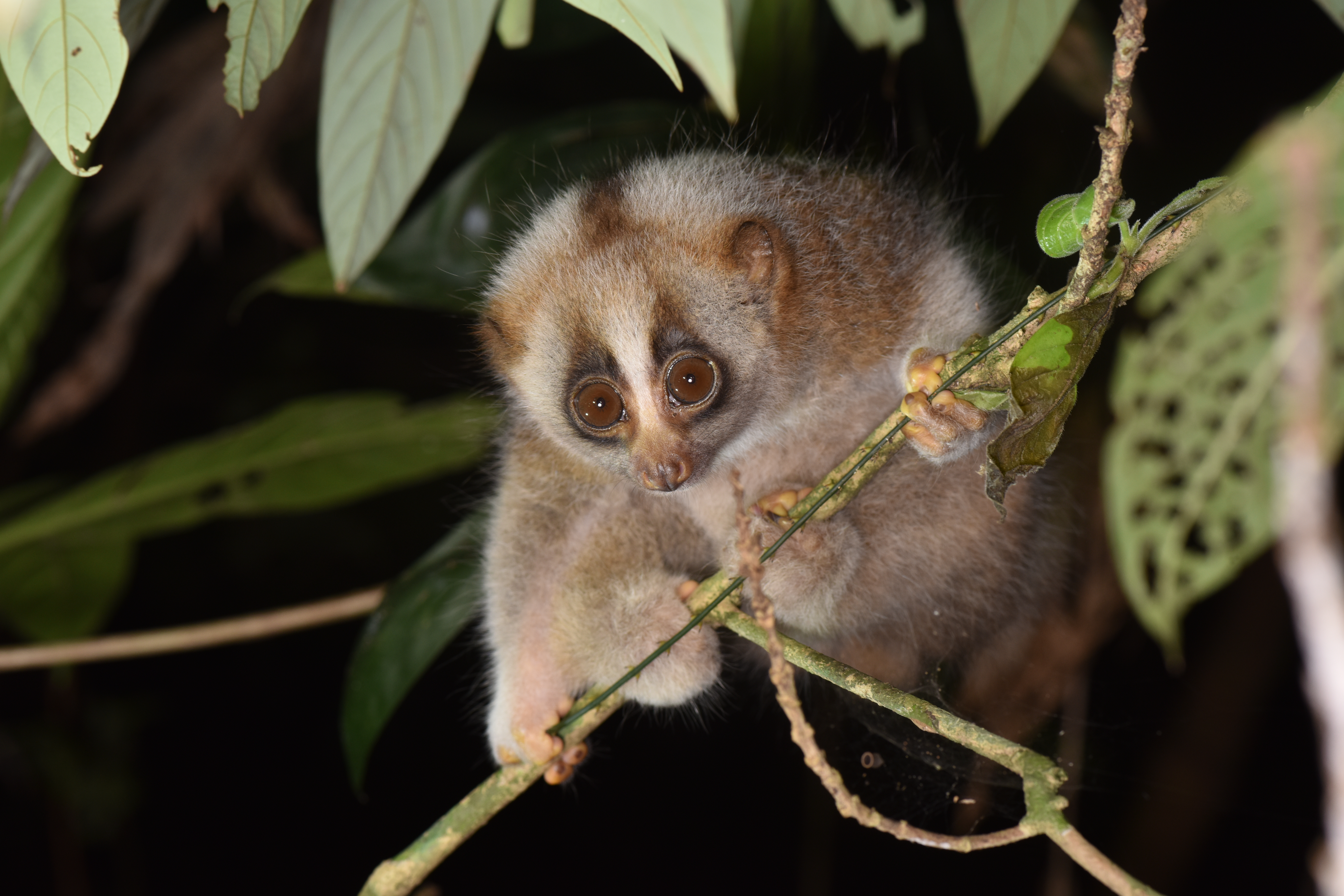Loris << LAWR ihs >> is a slow-moving animal that lives in trees. Lorises are primates—that is, members of the order of animals that includes monkeys, apes, and human beings. People sometimes use loris to mean all animals in the loris family, Lorisidae. The loris family includes lorises, which live in Asia; and pottos and angwantibos, which live in Africa. For information about pottos and angwantibos, see Potto.

Lorises have round heads, pointed faces, small ears, and enormous, forward-facing eyes. Lorises have either no tail or a short, stumpy one concealed in their fur. Lorises may be brown, gray, reddish, or yellowish. Their fur markings include dark rings around the eyes and a white stripe on the nose.
There are two main types of lorises—slender lorises and slow lorises. The smallest kind of loris is the red slender loris. It weighs about 3 1/2 ounces (100 grams) as an adult. The largest loris is the Bengal slow loris. It may weigh up to 4 1/2 pounds (2.1 kilograms). Most lorises grow 8 to 10 inches (20 to 25 centimeters) long and weigh 2/3 to 1 3/4 pounds (300 to 800 grams).
Slender lorises are found in India and Sri Lanka. They eat mainly insects. They may also eat other small animals, eggs, and parts of plants. Biologists think it is possible that some kinds of slender lorises are carnivorous (entirely meat-eating).


Slow lorises are found throughout Southeast Asia from India to Indonesia. Their preferred food is gum (thick tree sap). They also eat fruits, insects, and nectar.
Slow lorises are the only venomous primates. They have glands on their arms that produce a deadly venom. They mix the venom with their saliva and then bite their attackers. Their venomous bite helps them survive attacks by predators. They also use their venom in fights with other lorises. The venom is strong enough to kill a human being, though loris bites are not usually fatal. The bite produces a reaction like an allergic reaction. This reaction can worsen into fatal anaphylactic shock. Loris venom also causes necrosis (the death of living tissue). It can make people’s fingers fall off.
All lorises are nocturnal (active at night). During the night, they prowl around in search of food. Their large eyes help them see well in the dark. However, they cannot see colors. Lorises sleep during the day. A loris sleeps with its feet clasped around a branch and its body rolled into a ball, with its head tucked between its thighs.
Lorises are hunted by dogs, eagles, monitors, orangutans, and pythons. Lorises move silently to avoid attracting the attention of predators. To get around, they creep slowly along tree branches. But a loris can move quickly when it is frightened.
Lorises do not usually live in groups or look for food together. However, lorises that live in the same area socialize with one another. They communicate by vocalizing and by leaving their scents on trees and on one another. Some kinds of lorises play together. Both male and female adult lorises play with young lorises.
Some kinds of lorises breed throughout the year. Others have a breeding season that lasts about a month. Pregnancy is about six months long. A female loris gives birth to one or two babies at a time. The mother leaves the babies on a tree branch while she looks for food. Slender lorises grow to adulthood in about a year. Slow lorises take 1 1/2 to 2 years to mature. Lorises often socialize with their parents even after they have become independent.
Every kind of loris is decreasing in population. Most kinds are endangered. Two kinds, the Bangka slow loris and the Javan slow loris, are critically endangered (at high risk of becoming extinct in the near future). Various human activities, including deforestation, threaten lorises. Climate change is also a threat. Changing weather patterns force lorises to move to new areas, where they may not be able to find enough food or avoid hunters.
Images and videos of lorises often become popular online because viewers consider the animals to be cute. Many social media posts show untrained people handling lorises and keeping them as pets. Such portrayals may lead people to believe that lorises are harmless and friendly. However, lorises are wild animals. They do not make good pets. They often suffer health problems in captivity, even in zoos with expert caretakers.
Yet large numbers of lorises are captured illegally and sold as exotic pets. These lorises are often kept in crowded conditions. In such conditions, they frequently get into fights, and many slow lorises die from venomous bites. Since about the 1990’s, the internet has made it possible to sell animals illegally over a wider area. People in such places as Europe and Japan buy lorises illegally. Today, biologists work with governments and local communities to rescue lorises from the illegal pet trade and return them to the wild.
Various beliefs about lorises exist in culture, folklore, and traditional medicine. In some areas of South and Southeast Asia, people kill slow lorises to sell their body parts as medicine. For example, women who practice Khmer (Cambodian) traditional medicine consume slow loris parts after giving birth. Loris parts also are traditionally used to treat asthma and sexually transmitted diseases. The hunting of slow lorises for medicine harms people as well as lorises. People who hunt lorises are often bitten. They may be seriously injured by slow loris venom. 
Some traditional beliefs prevent people from harming lorises. For example, some people in the Sundanese ethnic group in Indonesia believe that killing a loris can have drastic consequences for the land. According to folklore, where the blood of a loris hits the ground, plants will die and the soil will dry out. In other places, people do not disturb slow lorises because they believe that the animals guard gates to the afterlife.
